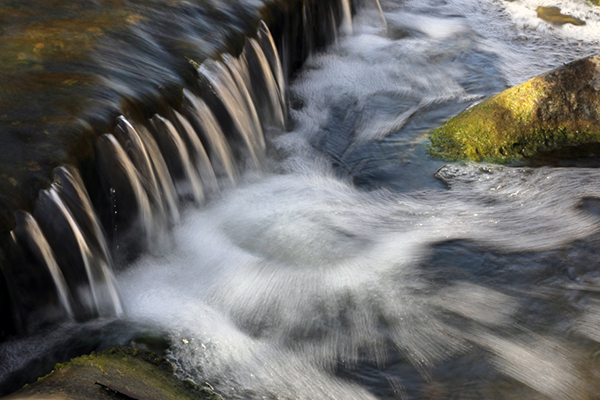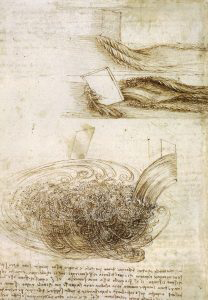Topsy-turvy Currents Key to Removing Nitrate from Streams, UCI-led Study Finds
Scientists calculate ‘speed limit’ for pumping pollutant to hungry algae, bacteria
This turbulence in Orange County’s Aliso Creek is analogous to patterns sketched by Leonardo da Vinci. UCI-led researchers have discovered that a similar phenomenon sweeps nitrate pollution to streambeds, potentially aiding in its removal by bacteria and algae growing on the bottom. Morvarid Azizian / UCI
New findings to be published Friday in the journal Science add another to the list: the eradication of a pervasive fertilizer pollutant from streams.
“We can now calculate a turbulence ‘speed limit’ for nitrate removal in any stream,” said lead author Stanley Grant, a professor of civil & environmental engineering at the University of California, Irvine. “That means we can provide specific guidance on how to tailor restoration efforts to maximize its removal and protect ecosystems downstream.”
Scientists have long known that nitrate-loaded fertilizers run off from farms and city streets into bodies of water, sometimes creating giant “dead zones” hundreds of miles downstream. The prevailing view has been that hungry algae and bacteria in the bottom sediment control how fast nitrate can be removed.
But an international team of researchers thought that physics might play a role too. Churning water serves as a sort of escalator, whirling molecules of the pollutant down to streambeds in a pattern that’s a vertical version of Leonardo’s long-ago sketches. Leonardo da Vinci sketched and wrote about “la turbolenza,” patterns that influence everything from the formation of Jupiter’s red spot to the eradication of pollutants in streams, according to new findings by a UCI-led team.
Public domain / Wikimedia Commons
The scientists wanted to know how that action affects elimination of the contaminant. They calculated the maximum velocity – or speed limit – at which turbulence moves nitrate to the sediment and compared it to previously published measurements of nitrate removal in 72 streams across the United States.
“The answer depends on how polluted the stream is,” said co-author Perran Cook, an associate professor of chemistry at Monash University in Australia. “In pristine streams, the rate at which turbulence transports the nitrate controls how quickly it’s removed. In polluted streams, the prevailing view is correct: Processes within the sediment win the day.”
In a clean stream, the nitrate is removed when the algae and bacteria in the sediment soak it up, or, even better, convert it to a harmless gas compound.
“It is a gigantic gift. Streams remove much of the nitrate we throw at them, so there has been a lot of interest in understanding how this process works and how it can be made more efficient,” said co-author Fulvio Boano, an associate professor of hydraulics at Italy’s Politecnico di Torino.
But the process can become overwhelmed when too much of the contaminant is pumped into a waterway, allowing nitrate to flow to coastal waters. Once there, it can stimulate algal growth, deplete oxygen, and lead to the formation of giant barren areas downstream, like the Connecticut-sized area off the Mississippi River Delta in the Gulf of Mexico.
The study results have important implications for managing nitrate pollution near the source, before it flows to sensitive ecosystems.
“The same calculations can be included in stream network models, which would allow researchers to better quantify the impacts of nitrate pollution at local, continental and even global scales,” said co-author Morvarid Azizian, a postdoctoral scholar in civil & environmental engineering at UCI.
“That’s a picture that would make even Leonardo proud,” Grant added.
Funding for the work was provided by the National Science Foundation and the UC Office of the President Multicampus Research Programs & Initiatives.
- Janet Wilson / UCI
